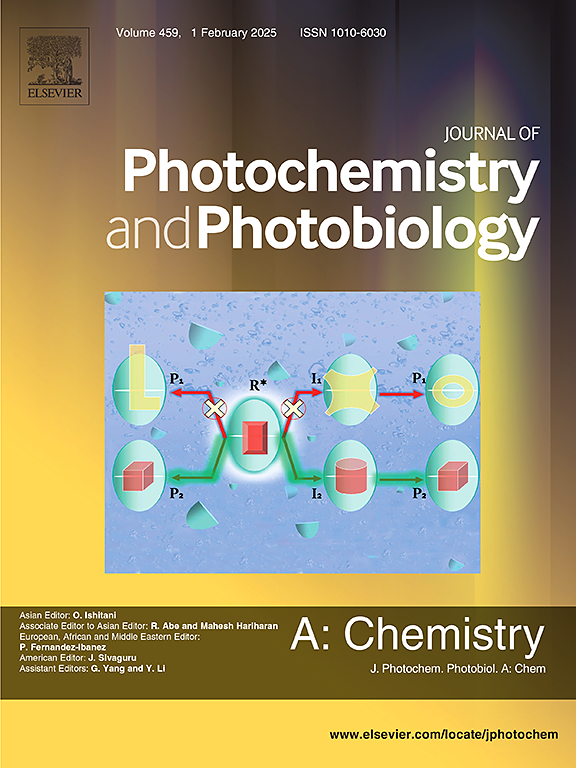基于B, S, N共掺杂碳点的高灵敏快速纳米探针用于人唾液胃蛋白酶活性监测及其细胞成像
IF 4.1
3区 化学
Q2 CHEMISTRY, PHYSICAL
Journal of Photochemistry and Photobiology A-chemistry
Pub Date : 2025-02-21
DOI:10.1016/j.jphotochem.2025.116349
引用次数: 0
摘要
胃食管反流病(GERD)是一种广泛存在的疾病,但由于其非特异性症状而难以筛查。检测唾液中的胃蛋白酶是一种非侵入性和特异性的诊断方法,但它需要提高反应时间、选择性和灵敏度。本研究首次建立了一种基于硼、硫、氮共掺杂碳点(BSN-CDs)的高灵敏度唾液胃蛋白酶活性检测方法。制备的BSN-CDs具有优异的光致发光性能,高水溶性,以及在不同盐浓度和pH水平下的稳定性。该纳米探针对胃蛋白酶的检测范围为0 ~ 60µg/mL,检测限为0.24µg/mL,具有快速的响应时间和较宽的检测范围,是临床诊断的重要工具。据我们所知,这是迄今为止报道的对胃蛋白酶活性反应最灵敏的材料。通过准确测定人唾液样品中的胃蛋白酶,证实了该方法的可行性,回收率在96.0% ~ 108.5%之间。此外,该研究还研究了使用这些碳点对HepG2和SiHa细胞进行成像,强调了它们更广泛的生物医学潜力。研究结果表明,BSN-CDs是一种很有前景的纳米材料,可用于灵敏的生物分子检测和先进的成像技术。本文章由计算机程序翻译,如有差异,请以英文原文为准。

B, S, N co-doped carbon dots-based highly sensitive and rapid nanoprobe for monitoring of pepsin activity in human saliva and its cell imaging
Gastroesophageal reflux disease (GERD) is widespread, but screening is difficult due to its non-specific symptoms. Detecting pepsin in saliva is a non-invasive and specific diagnostic method, yet it requires enhancements in reaction time, selectivity, and sensitivity. In this study, a highly sensitive detection method has been developed for monitoring pepsin activity in human saliva based on boron, sulfur, and nitrogen co-doped carbon dots (BSN-CDs) for the first time. The manufactured BSN-CDs exhibit exceptional photoluminescent properties, high water solubility, and stability in varying salt concentrations and pH levels. The nanoprobe shows a fast response time and a wide detection range from 0 to 60 µg/mL for pepsin with a detection limit of 0.24 µg/mL, making it a valuable tool for clinical diagnostics. To our knowledge, this is the most responsive material for pepsin activity reported to date. The method’s viability was confirmed by accurately measuring pepsin in human saliva samples, achieving recovery rates between 96.0 % to 108.5 %. Moreover, the study investigates using these carbon dots for imaging HepG2 and SiHa cells, highlighting their broader biomedical potential. It concludes that BSN-CDs are promising nanomaterials for sensitive biomolecule detection and advanced imaging techniques.
求助全文
通过发布文献求助,成功后即可免费获取论文全文。
去求助
来源期刊
CiteScore
7.90
自引率
7.00%
发文量
580
审稿时长
48 days
期刊介绍:
JPPA publishes the results of fundamental studies on all aspects of chemical phenomena induced by interactions between light and molecules/matter of all kinds.
All systems capable of being described at the molecular or integrated multimolecular level are appropriate for the journal. This includes all molecular chemical species as well as biomolecular, supramolecular, polymer and other macromolecular systems, as well as solid state photochemistry. In addition, the journal publishes studies of semiconductor and other photoactive organic and inorganic materials, photocatalysis (organic, inorganic, supramolecular and superconductor).
The scope includes condensed and gas phase photochemistry, as well as synchrotron radiation chemistry. A broad range of processes and techniques in photochemistry are covered such as light induced energy, electron and proton transfer; nonlinear photochemical behavior; mechanistic investigation of photochemical reactions and identification of the products of photochemical reactions; quantum yield determinations and measurements of rate constants for primary and secondary photochemical processes; steady-state and time-resolved emission, ultrafast spectroscopic methods, single molecule spectroscopy, time resolved X-ray diffraction, luminescence microscopy, and scattering spectroscopy applied to photochemistry. Papers in emerging and applied areas such as luminescent sensors, electroluminescence, solar energy conversion, atmospheric photochemistry, environmental remediation, and related photocatalytic chemistry are also welcome.

 求助内容:
求助内容: 应助结果提醒方式:
应助结果提醒方式:


